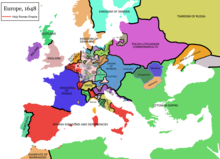1632 (novel): Difference between revisions
→Prologue: delete copyrighted prologue - not encyclopedic in any way, shape or form |
Redeagle688 (talk | contribs) m updated cleanup tag |
||
| Line 1: | Line 1: | ||
{{cleanup-date| |
{{cleanup-date|August 2006}} |
||
{{infobox Book | <!-- See Wikipedia:WikiProject_Novels or Wikipedia:WikiProject_Books --> |
{{infobox Book | <!-- See Wikipedia:WikiProject_Novels or Wikipedia:WikiProject_Books --> |
||
| name = 1632 |
| name = 1632 |
||
Revision as of 20:38, 12 August 2006
You must add a |reason= parameter to this Cleanup template – replace it with {{Cleanup|August 2006|reason=<Fill reason here>}}, or remove the Cleanup template.
| Cover of the lead novel - Rednecked Hillbillies meet mercenary soldiers of the Catholic league. First edition cover | |
| Author | Eric Flint |
|---|---|
| Country | USA |
| Language | English |
| Series | 1632 series |
| Genre | Alternate History, Novel |
| Publisher | Baen Books |
Publication date | February 1, 2000 |
| Media type | Print (Hardcover & Paperback) & ebook |
| Pages | 512 pp (first edition, hardback) |
| ISBN | ISBN 0671578499 (first edition, hardback) Parameter error in {{ISBNT}}: invalid character |
| Followed by | 1633 |
1632 is the initial novel in the best selling alternate history genre 1632 book series set in the Holy Roman Empire by historian, writer and editor Eric Flint. The flagship novel kicked off a remarkable collaborative writing effort that has involved hundreds of contributors, dozens of authors, and has published works now numbered well into the double digits—and if anything—is adding new titles at an increasingly fast pace (see: the two main articles). The premise involves a small American town of three thousand 'Hillbillies' sent back to April 1631, during the Thirty Years' War.


Plot summary
Template:Spoilers Flint created the fictional town of Grantville, WV (modeled on the real town of Mannington West Virginia) and dropped it and its power plant abruptly into the new time-space, through a side effect (an accident, in truth) of an alien technology (The Assiti Shards).

A hemispherical section of land about three miles in radius measured from the town center was transported back in time from April of 2000 (our time line 'OTL') into the middle of the Thirty Years' War, in the German province of Thuringia in the Thuringer Wald during May of 1631. This Assiti event occurred during a wedding, accounting for the presence of a few characters not native to the town, including an extra doctor and his daughter, a nurse. He created another nearby fictional German free city, (Badenburg) and plunged both populations into tentative contact. Real Thuringian municipalities located close to Grantville were posited as Weimar, Jena, Saalfeld and the more remote Erfurt, Arnstadt, and Eisenach; all located in the valley of the Saale River East of the Palatinate (Rhine) well to the south of Halle and Leipzig.
Grantville, led by Mike Stearns, President of the local United Mine Workers of America (UMWA), and a supporting cast of characters widely diverse in background and viewpoint coped with the town's space-time dislocation, the surrounding raging war, language barriers, and numerous social and politician issues, including class conflict, witchcraft, feminism, the reformation and the counter-reformation and strife (at its peak) among many other factors. One complication was a compounding of the town's food shortage when the town was flooded by refugees from the war. Flint also addressed the culture shock experienced by the 1631 locals viewing the mores of contemporary society, including modern dress, sexual liberation and boisterous American-style political rallies.
In a more practical vein, the plot covered short-term survival of the town, as well as the long-term question of how to maintain technology sundered from twenty-first century resources. Throughout 1631 Grantville manages to establish itself locally forming the nascent United States of Europe ('USE') with several local free cities (and a couple which aren't) while the war-clouds dog the northern German plain. But once Count Tilly falls during the Battle of Breitenfeld outside of Leipzig, King Gustavus Adolphus rapidly moves the war theater to Grantville's south into Franconia and Bavaria, both of which are on Grantvilles doorstep. The events of 1632 thereafter qualify as interesting times leading up to the creation of an awkward Confederated Principalities of Europe ('CPoE') and some measure of security for Grantville's up-timer and down-timer populations.
Characters in "1632"
Historical figures in the book
Several historical figures occupy prominent or supporting roles in the novel include King Gustavus Adolphus of Sweden, Count Tilly, and Albrecht von Wallenstein, all general officers of note and fame. And Cardinal Richelieu, takes on the role of the ultimate villain forced by circumstance in the later third of the work.
Characters of more than minor note
To the historical personalities, Flint adds a fictional characters of local origin (down-timers) including some with a real historical basis like the various members of the Abrabanel family (composite characters), or the holder of this or that office. He then creates action by introducing up-time Americans (i.e. those caught by the Ring of Fire from the future) in conversations large and small:
- Balthazar Abrabanel – Jewish Doctor, Spy, Financier to Kings
Release details
- 2000, USA, Pocket Books (ISBN 0671578499), Pub date ? February 2000, hardcover (First edition)
- 2001, USA, Baen Books (ISBN 0671319728), ? February 2001, paperback
- 2001, ?, Rebound by Sagebrush (ISBN 0613366719), ? October 2001, hardback (Library binding)
- 2006, USA, Baen Books (ISBN 1416532811), 30 June 2006, paperback
- The full text of the novel is available from the Baen Free Library as an e-book: February 2000, DOI:0671578499
For Publishing data on all books in the series, see Publishing History.
